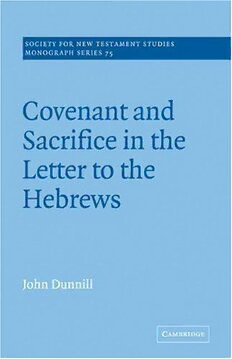
Covenant and Sacrifice in the Letter to the Hebrews (Society for New Testament Studies Monograph Series) PDF
309 Pages·1993·6.097 MB·English
Most books are stored in the elastic cloud where traffic is expensive. For this reason, we have a limit on daily download.
Preview Covenant and Sacrifice in the Letter to the Hebrews (Society for New Testament Studies Monograph Series)
Description:
Among the problems which Hebrews poses for interpretation, its use of sacrificial terminology must cause it to seem remote and obscure. Although the recent work of social anthropologists on the nature of religious systems has been applied by Old Testament scholars to the laws and symbols of the Pentateuch (upon which Hebrews draws in propounding its doctrine of salvation) this is the first sustained study of Hebrews to take account of these theories. Building on the work of such writers as Mary Douglas, Victor Turner, and Claude L?vi-Strauss, Hebrews is approached here as a 'structure of symbols', in which the symbol-system of the Old Testament covenant is re-presented and transposed. Motifs explored by the author include sacred time and space; liminality; the sacrificial function of blood, death, oaths, and blessings; and the narrative traditions of election and exclusion. Dr Dunnill assesses Hebrews, not as an argument, but as an act of symbolic communication expressing the possibility of direct communion with God; he thus aims to identify some of its underlying structures and reveal the source of its power.
See more
The list of books you might like
Most books are stored in the elastic cloud where traffic is expensive. For this reason, we have a limit on daily download.
